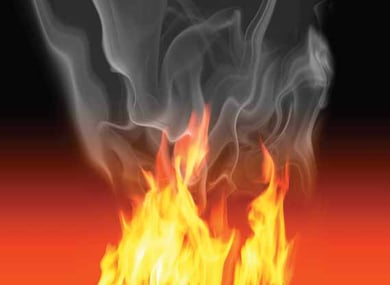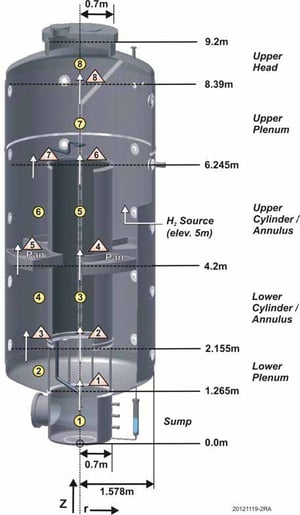FATE Software Applications in Nuclear, Chemical and Industrial Accident Response
By: Sung Jin Lee, Senior Consulting Engineer, Fauske & Associates and AnnMarie Fauske, Outreach, Fauske & Associates

FATETM 2.0 software is a general facility model developed by Fauske & Associates (FAI), a wholly owned subsidiary of Westinghouse Electric Company, LLC. FATE is used for process analyses, which considers engineering process components as well as an entire facility analyzing facility response, including transport and distribution of evolved gas and contamination, fire and smoke migration and room heat-up. It calculates temperatures, pressures, flow rates and compositions for fluids, gases and structures associated with a nuclear or chemical process and its surrounding facility. The FATE predecessor won U.S. DOE award for metallic spent nuclear fuel applications.
F - Flow of gases, vapor and particulates in a compartmentalized facility
A - Aerosol generation and transport
T - Thermal response of rooms and equipment
E - Explosion hazards from flammable gases and entrained particulates (dust)
Here is a list of FATE applications, which should give some idea about the code’s capabilities - such as a current application involving flammable concentration evolution during the operation of a major manufacturer's sand blender, where sand molds are broken up after being used and are fed into the blender to break up the remaining sand chunks. Flammable gas is released as the resin in the sand decomposes in the blender. In another industrial application, FATE is used to show that pressure transient in a newly designed flange guard device, which is clamped around a flanged pipe connection and has an open vent pipe, remains below the design pressure in the event of “pinhole” leak in the pipe gasket. In both applications, FAI will identify the pertinent phenomena, set up a simple FATE model, make parametric runs, and report the results with one or two weeks of effort.
More:
- The transient and severe accident analysis capability of the SAS4A/SASSYS-1 code developed by Argonne National Laboratory is coupled with the radionuclide transport analysis capability of the FATE code to predict radionuclide release from a broad spectrum of accidents that can be postulated to occur at liquid metal cooled reactor facilities.
- Hydrogen combustion consequences in a 3 cubic meter Box and Skip including the effect of heat transfer to walls
- Diesel generator room heat up during the loss of ventilation event was analyzed. A simple FATE model was built to validate the GOTHIC calculation
- Hydrogen risk during the steam generator wet layup additive process was analyzed. The secondary side of the steam generator and piping leading up to the automatic relief valves were modeled using FATE.
- Hydrogen accumulation in the AP1000 auxiliary building and primary containment building was analyzed in the event of a break in the chemical and volume control system (CVS) hydrogen injection line
 Transient thermal response of concrete walls within the facility was analyzed during postulated upset scenarios where pool cooling is unavailable and the fuel storage halls are cooled either by active ventilation or natural circulation for an extended duration
Transient thermal response of concrete walls within the facility was analyzed during postulated upset scenarios where pool cooling is unavailable and the fuel storage halls are cooled either by active ventilation or natural circulation for an extended duration- The drying process of damaged fuel chunks in an nuclear reactor was simulated
- Transient model of HCl gas release in a vessel and piping system
- Transient thermal and gas generation analyses for planned loading of sludge basins was analyzed. In particular, this simulation addresses the off-normal scenario for the loss of active ventilation after sludge loading prior to its transport.
- Transient thermal and gas generation relevant to the vent/purge process step following receipt of sludge in a Sludge Transport and Storage Container (STSC) was analyzed
- Used fuel drying in a special container was simulated
- Evaluated the risk from flammable gas accumulation in the buildings attached external to the containment by modeling the transport and distribution of leaked flammable gas (hydrogen and carbon monoxide) in the penetration buildings
- Gas generation and flow were analyzed for an ingot casting facility being constructed in the US. During the ingot producing process, occasionally a break in the mold will develop, allowing the molten metal to spill out of the hardened ingot into the casting pit, producing hydrogen through a reaction of water with lithium and aluminum.
- Transient thermal and gas generation analyses for planned transport of sludge in STSCs
- Transient thermal and gas generation analyses for planned transport and interim storage of sludge in STSC
- The dry cask storage (DCS) of spent nuclear fuel assemblies was analyzed for steady-state thermal behavior in an isolated loss-of-flow condition. The thermal analysis must assure that the peak cladding temperature remains below the regulatory limit for the dehumidification process.
- Transient thermal and gas generation analyses for transportation of settler sludge in the STSC
- Predictions for the nominal performance of cold vacuum drying (CVD) of knock out pot (KOP) material, as well as behavior of the system in off-normal and accident conditions. Results of the calculations can form a basis for process design, system design, operating procedures, and safety documentation including technical safety requirements.
- Transient thermal and gas analyses of candidate conceptual designs for shipping from the basins and storage of sludge
- Analysis of settler sludge thermal, gas generation, and gas storage behavior during retrieval and interim storage. There are two specific system areas for analysis: Transfer piping, which is bounded by a filter, and a storage container.
- Scoping thermal and gas calculations for a container sludge retrieval system. This is a scoping evaluation to assist in design and hazard evaluation as part of integration of safety into design.
- A fire was simulated to quantify the potential for equipment damage and fire propagation for reactor building rooms and corridors in Fire Zone 1
- Analysis of heat transfer, chemical reactions, and gas generation for retrieval and transfer of sludge from the vacuum drying facility via a double-contained line, an essential phase prior to processing of sludge to remove reactive metal.
- Thermal and chemical process simulation of the aqueous sludge corrosion process. The scope includes normal operation and recovery from selected off-normal and accident conditions. The model considers the corrosion vessel, quench vessel, process enclosure, process off-gas piping, and vacuum drying bays.
- The leak path factor (LPF), the fraction of material released in the facility that is transported to the environment, is determined by modeling the facility including active systems
- Thermal response and hydrogen gas generation are examined in the Fuel Transfer System (FTS) for fuel transfer
- Analysis of heat transfer, chemical reactions and gas generation for transfer of sludge via a double-contained line and sludge loading and staging in consolidation containers
- Independent calculations for thermal and chemical reaction response of Spent Nuclear Fuel (SNF) sludge in a large diameter container (LDC) for select transportation and storage scenarios
- A simulation of the behavior of the contents of a multi-canister overpack container (MCO) from the inception of cold vacuum drying through interim storage. The simulations include prediction of fuel temperatures, gas temperature, gas composition, and pressure, and address the potential for ignition of fuel.
- Consequences of air ingress into an MCO during vacuum drying. A separate detailed assessment of the effect of hydride inclusions and the potential for ignition.
- A mechanistic model of organic-nitrate reactions initiated in hypothetically reactive waste in underground storage tanks. A thermal-hydraulic assessment of tank transient pressure and temperature to yield flows of gases to the environment, a release model to predict vaporization of volatile materials from reacted waste, and an aerosol transport and deposition model to provide the source term to the environment.
We thought this information was relevant to share and discuss as FATE's code capabilities are vast. Your facility may have an innovative idea or need to address similar issues for which FATE can be tailored to suit. If you'd like to learn more about FATE, check out FAI's work on the Development of the Source Term Analysis Tool SAS4A-FATE for Lead-and Sodium-Cooled Fast Reactors by clicking below.

